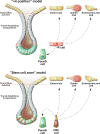The intestinal stem cell
- PMID: 18628392
- PMCID: PMC2735277
- DOI: 10.1101/gad.1674008
The intestinal stem cell
Abstract
The epithelium of the adult mammalian intestine is in a constant dialog with its underlying mesenchyme to direct progenitor proliferation, lineage commitment, terminal differentiation, and, ultimately, cell death. The epithelium is shaped into spatially distinct compartments that are dedicated to each of these events. While the intestinal epithelium represents the most vigorously renewing adult tissue in mammals, the stem cells that fuel this self-renewal process have been identified only recently. The unique epithelial anatomy makes the intestinal crypt one of the most accessible models for the study of adult stem cell biology. This review attempts to provide a comprehensive overview of four decades of research on crypt stem cells.
Figures



Similar articles
-
EGF signaling activates proliferation and blocks apoptosis of mouse and human intestinal stem/progenitor cells in long-term monolayer cell culture.Lab Invest. 2010 Oct;90(10):1425-36. doi: 10.1038/labinvest.2010.150. Epub 2010 Aug 16. Lab Invest. 2010. PMID: 20714325
-
Regulation and plasticity of intestinal stem cells during homeostasis and regeneration.Development. 2016 Oct 15;143(20):3639-3649. doi: 10.1242/dev.133132. Development. 2016. PMID: 27802133 Review.
-
Stem cell and progenitor fate in the mammalian intestine: Notch and lateral inhibition in homeostasis and disease.EMBO Rep. 2015 May;16(5):571-81. doi: 10.15252/embr.201540188. Epub 2015 Apr 8. EMBO Rep. 2015. PMID: 25855643 Free PMC article. Review.
-
Regulation of intestinal stem cells in mammals and Drosophila.J Cell Physiol. 2010 Jan;222(1):33-7. doi: 10.1002/jcp.21928. J Cell Physiol. 2010. PMID: 19739102 Review.
-
Lineage selection and plasticity in the intestinal crypt.Curr Opin Cell Biol. 2014 Dec;31:39-45. doi: 10.1016/j.ceb.2014.07.002. Epub 2014 Sep 15. Curr Opin Cell Biol. 2014. PMID: 25083805 Free PMC article. Review.
Cited by
-
Comparative evaluation of the genomes of three common Drosophila-associated bacteria.Biol Open. 2016 Sep 15;5(9):1305-16. doi: 10.1242/bio.017673. Biol Open. 2016. PMID: 27493201 Free PMC article.
-
Tumorigenic fragments of APC cause dominant defects in directional cell migration in multiple model systems.Dis Model Mech. 2012 Nov;5(6):940-7. doi: 10.1242/dmm.008607. Epub 2012 Apr 5. Dis Model Mech. 2012. PMID: 22563063 Free PMC article.
-
Intestinal stem cells.Curr Gastroenterol Rep. 2010 Oct;12(5):340-8. doi: 10.1007/s11894-010-0130-3. Curr Gastroenterol Rep. 2010. PMID: 20683682 Free PMC article. Review.
-
Variations in the management of diarrhoea induced by cancer therapy: results from an international, cross-sectional survey among European oncologists.ESMO Open. 2019 Dec 1;4(6):e000607. doi: 10.1136/esmoopen-2019-000607. eCollection 2019. ESMO Open. 2019. PMID: 31803505 Free PMC article.
-
Physiological relevance of cell-specific distribution patterns of CFTR, NKCC1, NBCe1, and NHE3 along the crypt-villus axis in the intestine.Am J Physiol Gastrointest Liver Physiol. 2011 Jan;300(1):G82-98. doi: 10.1152/ajpgi.00245.2010. Epub 2010 Oct 28. Am J Physiol Gastrointest Liver Physiol. 2011. PMID: 21030607 Free PMC article.
References
-
- Andreu P., Colnot S., Godard C., Gad S., Chafey P., Niwa-Kawakita M., Laurent-Puig P., Kahn A., Robine S., Perret C., et al. Crypt-restricted proliferation and commitment to the Paneth cell lineage following Apc loss in the mouse intestine. Development. 2005;132:1443–1451. - PubMed
-
- Asai R., Okano H., Yasugi S. Correlation between Musashi-1 and c-hairy-1 expression and cell proliferation activity in the developing intestine and stomach of both chicken and mouse. Dev. Growth Differ. 2005;47:501–510. - PubMed
-
- Barker N., van Es J.H., Kuipers J., Kujala P., van den Born M., Cozijnsen M., Haegebarth A., Korving J., Begthel H., Peters P.J., et al. Identification of stem cells in small intestine and colon by marker gene Lgr5. Nature. 2007;449:1003–1007. - PubMed
-
- Batlle E., Henderson J.T., Beghtel H., van den Born M.M., Sancho E., Huls G., Meeldijk J., Robertson J., de van Wetering M., Pawson T., et al. β-Catenin and TCF mediate cell positioning in the intestinal epithelium by controlling the expression of EphB/ephrinB. Cell. 2002;111:251–263. - PubMed
-
- Bjerknes M., Cheng H. The stem-cell zone of the small intestinal epithelium. I. Evidence from Paneth cells in the adult mouse. Am. J. Anat. 1981a;160:51–63. - PubMed
Publication types
MeSH terms
LinkOut - more resources
Full Text Sources
Other Literature Sources
Medical
